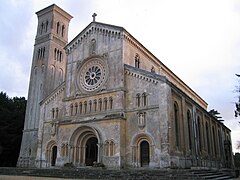Wilton, Wiltshire
| Wilton | |
|---|---|
 St Mary & St Nicholas' parish church |
|
| Wilton shown within Wiltshire | |
| Population | 3,579 (2011 census) |
| OS grid reference | SU096312 |
| Civil parish |
|
| Unitary authority | |
| Ceremonial county | |
| Region | |
| Country | England |
| Sovereign state | United Kingdom |
| Post town | Salisbury |
| Postcode district | SP2 |
| Dialling code | 01722 |
| Police | Wiltshire |
| Fire | Dorset and Wiltshire |
| Ambulance | South Western |
| EU Parliament | South West England |
| UK Parliament | |
| Website | Town Council |
Wilton is a town and civil parish in Wiltshire (of which it was once the county town), England, with a rich heritage dating back to the Anglo-Saxons. Carpets have been manufactured at Wilton since the 18th century. Today it is overshadowed by its larger neighbour, Salisbury, but still has a range of notable shops and attractions, including Wilton House.
The confluence of the rivers Wylye and Nadder is at Wilton.
The history of Wilton dates back to the Anglo-Saxons in the 8th century AD, and by the late 9th century it was the capital of Wiltunscire, a shire of the Kingdom of Wessex. It remained the administrative centre of Wiltshire until the 11th century. Wilton was of significant importance to the church, with the founding of Wilton Abbey in AD 771 and a number of other establishments. In AD 871 Alfred the Great fought and lost an important battle there against the Danish armies, leaving him in retreat for several years.
Despite further attacks, Wilton remained a prosperous town, as recorded in the Domesday book. The building of Salisbury Cathedral nearby, however, caused Wilton's decline, as the new site of Salisbury, with a new bridge over the River Avon, provided a convenient bypass around Wilton on the trade routes.
Wilton Abbey was surrendered to Henry VIII in 1539 during the Dissolution of the Monasteries, and in 1541 much of the estate was granted to Earl William Herbert of Pembroke, upon which Wilton House was built.
...
Wikipedia

